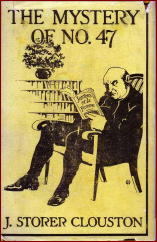Wed 18 Sep 2013
Retro Review [The Bookman, 1912]: J. STORER CLOUSTON – The Mystery of No. 47.
Posted by Steve under Reviews[11] Comments
FREDERIC TABER COOPER:
J. STORER CLOUSTON РThe Mystery of No. 47. Moffat Yard & Co., US, hardcover, 1911. Published in the UK as His First Offence: Mills, hardcover, 1912. Film: Lenauer (France), 1937, as Dr̫le de Drame.

The Mystery of No. 47, by J. Storer Clouston, does not pretend to be anything more than a diverting extravaganza, the thesis of which, so far as it has any, is simply the utter unreliability of circumstantial evidence.
A quiet, and eminently respectable young couple are thrown into a state of mild consternation when the husband’s uncle, an eminent bishop, happens to invite himself to dinner on the very night when the cook has chosen to take sudden leave. There seems to be only one thing to do: the bishop must be told that the wife has gone away for a day or two, to visit a sick relative — while, as a matter of fact, she simply retires to the kitchen, to provide for his entertainment.
Now the bishop happens to be a suspicious and evil-minded man, who quickly discovers that his nephew has been lying to him, and is incapable of imagining any innocent motive for the lies. He leaps to the conclusion that the nephew is carrying on a clandestine affair with the pretty housemaid, and that, finding his wife a stumbling block, he has made way with her and probably buried the body in the back garden. Accordingly he forthwith notifies Scotland Yard.
Now the nephew is a novelist, and at his wife’s suggestion, instead of telling the truth and clearing up the mystery, he helps his wife to go into hiding, while he himself assumes a disguise, and, posing as a detective or reporter, returns to his home, intending to pile up evidence against himself and utilise it for a forthcoming novel.
The cross-purposes and mystifications that follow, and the extent to which he over-reaches himself, until he almost finds himself in a hangman’s noose, all make excellent nonsense, so long as one is not too exacting. Of its kind, the book is a clever and amiable piece of pleasantry.”
September 19th, 2013 at 10:39 am
The film version “Drôle de drame” is delightful.
I keep meaning to track down the book, but never have.
So this review is informative.
J. Storer Clouston was known both as a crime writer and as a humorist, during his lifetime. He wrote a much-anthologized short story, “Coincidence”, from Carrington’s Cases (1920).
September 19th, 2013 at 10:41 am
A free e-book is available at:
https://archive.org/details/cihm_88151
September 19th, 2013 at 11:16 am
Thanks for the link, Mike. This old review made the book sound very interesting and had me wishing that I could come up with an inexpensive copy to read. I can’t think of anything cheaper than a free ebook online.
September 19th, 2013 at 7:06 pm
His books about Francis Mandell Essington, aka “The Lunatic”, are rather good. Similar to Wodehouse but more absurd. Lots of fun and not too dated. I have four of the five in the series. The books have titles like The Lunatic at Large, The Lunatic Still at Large, The Lunatic in Charge, etc. etc.
September 19th, 2013 at 8:18 pm
Any author similar to but more absurd than Wodehouse is an author worth pursuing, that’s for sure. Thanks, John!
September 20th, 2013 at 1:08 am
From CRIME FICTION IV:
Mandell-Essington, Francis
J. Storer Clouston: (books)
The Lunatic at Large (n.) Blackwood 1899 [England]
Count Bunker (n.) Blackwood 1906 [England]
The Lunatic at Large Again (n.) Nash 1922 [England]
The Lunatic Still at Large (n.) Nash 1923 [England]
The Lunatic in Charge (n.) Bodley Head 1926 [England]
Mr. Essington in Love (n.) Lane 1927 [England]
The Best Story Ever (n.) Blackwood 1932 [England]
September 20th, 2013 at 8:29 am
Unfortunately, a lot of Clouston’s best output post-dates 1922, but we do have THE LUNATIC AT LARGE available for free:
– http://www.unz.org/Pub/CloustonJStorer-1901
– http://www.gutenberg.org/ebooks/20485
The UNZ index page for J. Storer Clouston has reviews of four other LUNATIC novels:
– http://www.unz.org/Author/CloustonJStorer
Wikipedia:
– “J. Storer Clouston”
– http://en.wikipedia.org/wiki/J._Storer_Clouston
September 20th, 2013 at 9:13 am
I’ve read the first two LUNATIC books and while they depend too much on coincidence they were quite funny. No one , it seems to me, has quite the purity of diction that Wodehouse had or his ability to keep several sub-plots in the air before bringing them to a satisfying conclusion. However, this book sounds well worth reading.
September 20th, 2013 at 10:05 am
Thanks for posting this review, Steve! I’m in the mood for a comedic crime caper, and Clouston sounds like an good choice. I’ve been buried in noir lately.
September 20th, 2013 at 11:11 am
BV
Thank you for hosting this week’s assortment of Friday’s “Forgotten” Books, and for including this one.
Here’s the the full list:
http://inreferencetomurder.typepad.com/my_weblog/2013/09/fridays-forgotten-books-weekly-roundup.html
An interesting collection of authors and titles, as always.
September 20th, 2013 at 6:15 pm
This sounds fun. A stretch, as far as credibility goes, but the type of Wodehouseian shenanigans I enjoy.